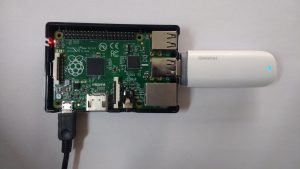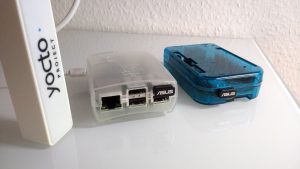
Add mobile broadband connectivity to Embedded Linux
In this article we will show how to extend an IoT Embedded Linux System with a broadband connection using 3G/4G networks.
Poky/Yocto is used as Linux distribution in combination with the mobile telephony application oFono.
As hardware example we have a raspberrypi, nevertheless the same setup was applied and verified on other standard development kits and custom boards.
For the broadband connectivity Huawei E173 3G USB stick is used:

If using a different modem, check first if it’s supported with oFono. Here is a list of supported hardware.
Kernel configuration
In order to support 3G USB modems, the following kernel configuration options
need to be enabled :
CONFIG_USB_SERIAL=y CONFIG_USB_SERIAL_GENERIC=y CONFIG_USB_SERIAL_WWAN=m CONFIG_USB_SERIAL_OPTION=m CONFIG_PPP=m CONFIG_PPP_MULTILINK=y CONFIG_PPP_FILTER=y CONFIG_PPP_ASYNC=m CONFIG_PPP_SYNC_TTY=m
If those options are used, you should see the following in dmesg:
usbserial: USB Serial support registered for GSM modem (1-port) GSM modem (1-port) converter detected usb 1-1.3: GSM modem (1-port) converter now attached to ttyUSB0 option 1-1.3:1.1: GSM modem (1-port) converter detected usb 1-1.3: GSM modem (1-port) converter now attached to ttyUSB1 option 1-1.3:1.2: GSM modem (1-port) converter detected usb 1-1.3: GSM modem (1-port) converter now attached to ttyUSB2
Yocto recipes
To support oFono, the image recipe should include the following packages:
IMAGE_INSTALL += "ofono ofono-tests"
To allow ofono integration with network manager connman, the following packages can be added:
IMAGE_INSTALL += "connman connman-client"
Connman shall be then enabled with 3g support:
PACKAGECONFIG_append_pn-connman = " 3g"
Ofono setup
oFono provides a mobile telephony (GSM/UMTS) application framework that includes consistent, minimal, and easy to use complete APIs. It offers a high-level D-Bus API for use and integrate with other applications.
The advantage of using oFono is that very simple to configure and you will not have to deal with any kind of AT commands.
Plug in your 3G modem and check if recognized by oFono:
root@raspberrypi:/usr/lib/ofono/test# ./list-modems
[ /huawei_0 ]
Type = hardware
Powered = 1
Serial = 860051019861709
Manufacturer = huawei
Model = E173
Emergency = 0
Online = 0
Features = sim
Lockdown = 0
Revision = 11.126.16.04.00
Interfaces = org.ofono.SimManager
[ org.ofono.SimManager ]
BarredDialing = 0
Present = 1
CardIdentifier = 89492019165001742330
LockedPins = pin
PinRequired = pin
FixedDialing = 0
PreferredLanguages = de en
Retries = [puk2 = 10] [pin2 = 3] [pin = 3] [puk = 10]
SubscriberNumbers =
Enable modem:
root@raspberrypi:/usr/lib/ofono/test# ./enable-modem Connecting modem /huawei_0...
If SIM card is protected with pin, enter the code:
root@raspberrypi:/usr/lib/ofono/test# ./enter-pin pin 1234 Enter Pin for modem /huawei_0...
Depending on the country and Network provider, APN setting is to be configured:
root@raspberrypi:/usr/lib/ofono/test# ./create-internet-context internet.eplus.de Found context /huawei_0/context1 Setting APN to internet.eplus.de
Now the modem can be set online and activated:
root@raspberrypi:/usr/lib/ofono/test# ./online-modem root@raspberrypi:/usr/lib/ofono/test#./activate-context
Here is an example script of modem initialization:
#!/bin/sh
#set -x
MODEM="/huawei_0"
PIN="1234"
APN="internet.eplus.de"
OFONO_DIR=/usr/lib/ofono/test
export PATH=$OFONO_DIR:$PATH
enable-modem $MODEM
if [ -n "$PIN" ]; then
enter-pin $MODEM pin $PIN
fi
create-internet-context $APN
online-modem $MODEM
activate-context
That’s it! the modem is up and the broadband connection is enabled:
root@raspberrypi:/usr/lib/ofono/test# ifconfig
eth0 Link encap:Ethernet HWaddr B8:27:EB:C4:02:82
UP BROADCAST MULTICAST MTU:1500 Metric:1
RX packets:0 errors:0 dropped:0 overruns:0 frame:0
TX packets:0 errors:0 dropped:0 overruns:0 carrier:0
collisions:0 txqueuelen:1000
RX bytes:0 (0.0 B) TX bytes:0 (0.0 B)
lo Link encap:Local Loopback
inet addr:127.0.0.1 Mask:255.0.0.0
inet6 addr: ::1%694092/128 Scope:Host
UP LOOPBACK RUNNING MTU:65536 Metric:1
RX packets:1120 errors:0 dropped:0 overruns:0 frame:0
TX packets:1120 errors:0 dropped:0 overruns:0 carrier:0
collisions:0 txqueuelen:1
RX bytes:81280 (79.3 KiB) TX bytes:81280 (79.3 KiB)
ppp0 Link encap:UNSPEC HWaddr 00-00-00-00-00-00-00-00-00-00-00-00-00-00-00-00
inet addr:10.148.173.91 P-t-P:10.148.173.91 Mask:255.255.255.255
UP POINTOPOINT RUNNING NOARP MULTICAST MTU:1500 Metric:1
RX packets:17 errors:0 dropped:0 overruns:0 frame:0
TX packets:18 errors:0 dropped:0 overruns:0 carrier:0
collisions:0 txqueuelen:500
RX bytes:1762 (1.7 KiB) TX bytes:1207 (1.1 KiB)
The cellular connection is also available in connman:
root@raspberrypi:/usr/lib/ofono/test# connmanctl technologies /net/connman/technology/cellular Name = Cellular Type = cellular Powered = True Connected = True Tethering = False /net/connman/technology/ethernet Name = Wired Type = ethernet Powered = True Connected = False Tethering = False
we can for example enable cellular connection tethering over wifi:
root@raspberrypi:# sysctl -w net.ipv4.ip_forward=1 root@raspberrypi:# connmanctl tether wifi on EmbexuSpot 123456789
If having problem to connect with cellular network, you can use list-modem to check the connection status:
root@raspberrypi:/usr/lib/ofono/test# ./list-modems
[ /huawei_1 ]
Type = hardware
Model = E173
Powered = 1
Interfaces = org.ofono.Phonebook org.ofono.ConnectionManager org.ofono.CellBroadcast org.ofono.NetworkRegistration org.ofono.SupplementaryServices org.ofono.CallBarring org.ofono.CallSettings org.ofono.CallF
Revision = 11.126.16.04.00
Serial = 860051019861709
Online = 1
Features = gprs cbs net ussd sms rat sim
Emergency = 0
Manufacturer = huawei
Lockdown = 0
[ org.ofono.Phonebook ]
[ org.ofono.ConnectionManager ]
Attached = 1
Suspended = 0
Powered = 1
Bearer = umts
RoamingAllowed = 0
[ org.ofono.CellBroadcast ]
Topics =
Powered = 0
[ org.ofono.NetworkRegistration ]
LocationAreaCode = 51906
MobileCountryCode = 262
CellId = 33184422
Mode = auto
Technology = umts
Status = registered
MobileNetworkCode = 03
Name = Blau
Strength = 41
[ org.ofono.SupplementaryServices ]
State = idle
[ org.ofono.CallBarring ]
VoiceOutgoing = disabled
VoiceIncoming = disabled
[ org.ofono.CallSettings ]
VoiceCallWaiting = disabled
HideCallerId = default
ConnectedLineRestriction = unknown
CallingNamePresentation = unknown
CalledLinePresentation = disabled
ConnectedLinePresentation = unknown
CallingLineRestriction = off
CallingLinePresentation = enabled
[ org.ofono.CallForwarding ]
VoiceNoReply =
VoiceNotReachable = +491793000400
VoiceUnconditional =
ForwardingFlagOnSim = 0
VoiceNoReplyTimeout = 20
VoiceBusy = +491793000400
[ org.ofono.MessageWaiting ]
VoicemailMessageCount = 0
VoicemailWaiting = 0
VoicemailMailboxNumber = +491779911
[ org.ofono.SmartMessaging ]
[ org.ofono.PushNotification ]
[ org.ofono.MessageManager ]
Alphabet = default
ServiceCenterAddress = +491770610000
UseDeliveryReports = 0
Bearer = cs-preferred
[ org.ofono.RadioSettings ]
GsmBand = any
TechnologyPreference = any
UmtsBand = any
[ org.ofono.AudioSettings ]
Active = 0
[ org.ofono.VoiceCallManager ]
EmergencyNumbers = 08 000 999 110 112 911 118 119
[ org.ofono.AllowedAccessPoints ]
[ org.ofono.SimManager ]
PreferredLanguages = de en fr
SubscriberIdentity = 262032735704422
FixedDialing = 0
MobileNetworkCode = 03
MobileCountryCode = 262
LockedPins = pin
CardIdentifier = 894921002875759225
BarredDialing = 0
SubscriberNumbers =
PinRequired = none
Present = 1
Retries = [pin2 = 3] [puk2 = 10] [puk = 10] [pin = 3]

